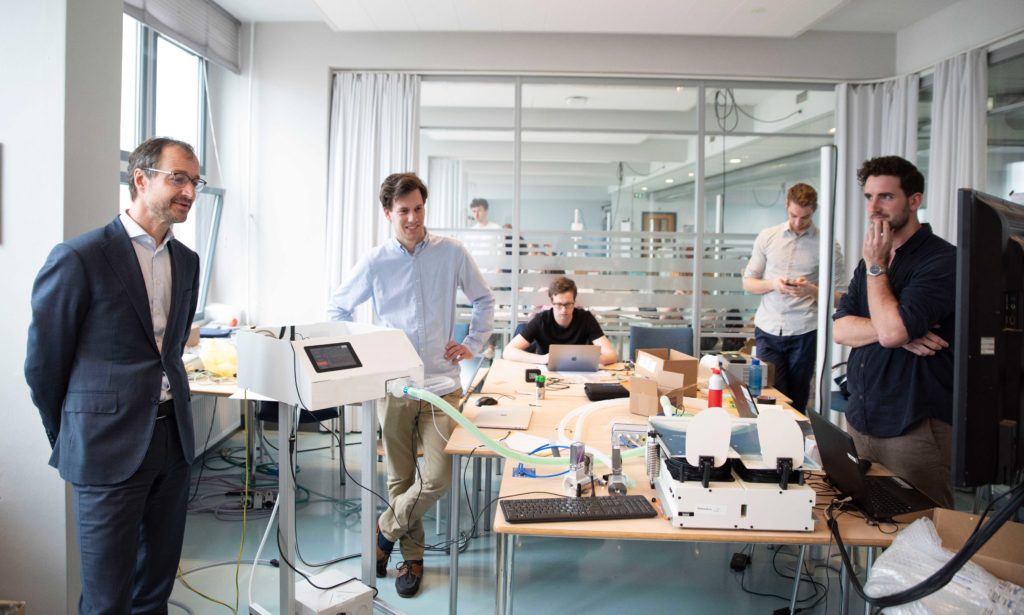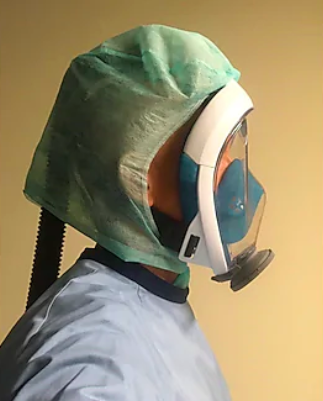Companies, organizations and individuals continue to attempt to lend support to the COVID-19 pandemic supply effort. We will be providing regular updates about these initiatives where necessary in an attempt to ensure that the 3D printing community is aware of what is being done, what can be done and what shouldn’t be done to provide coronavirus aid.
The Shell Technology Center Amsterdam (STCA) is using its 3D printers to produce a number of medical products in the Netherlands and abroad. With a foundation called Air Wave, the oil giant is developing a new face mask that uses a motor to filter air, similar to those used in asbestos remediation. One particular issue with such a mask is the loud sound of the motor, which can distract a medical worker. Shell is in the process of modifying the mask to reduce the noise and airflow from the device in an oxygen tight environment, virtually eliminating the chance that particles will enter the parts during printing.

A TU Delft team showing its ventilator prototype to experts from the Leiden University Medical Center and the Erasmus Medical Center. Image courtesy of Operation Air.
Via British Shell, the petro company is 3D printing face masks with varying levels of hardness so that the area touching the wearer’s face is the softest. Shell is also lending its efforts to a team at TU Delft, who have developed a ventilator for Dutch hospitals. Shell is printing the nylon connectors and housing for electrical equipment. So far, the conglomerate has printed parts for 80 ventilators. Additionally, Shell has printed 35,000 clips designed to secure face masks.
Goodyear is also making face shields, starting with the Centre Hospitalier de Luxembourg, for whom the tire maker made 500 face shields using its own 3D printers. Others performing similar tasks are Titan Robotics, which is using its large-scale pellet extrusion system, Atlas, to print face shield brackets at a rate of one per 5.5 minutes in the U.S. In Italy, Weerg and PressUP have made 500 face shields. Nexteer Automotive is making face shields in Poland, aiming at a rate of 100 per day. Paragon Rapid Technologies and RPS have made over 5000 face shields for hospitals in North East England. FIT AG has so far delivered 5,000 filter carriers using a drive-in service in Germany.
3D Systems has contributed its efforts to the production of nasal test swabs. The availability of testing systems and trained staff varies from location to location, with Todd Goldstein, director of 3D Design and Innovation at Northwell Health, indicating that Northwell’s providers had no issue with machines or staff, but needed to ensure a steady supply of test swabs.

3D Systems’ 3D-printed nasal swabs being made with the Figure 4 system. Image courtesy of 3D Systems.
3D Systems is currently validating its nasal swabs, printed by Figure 4 machines using autoclavable, biocompatible materials. The company claims that its Figure 4 printer can produce 273 swabs in 2.5 hours or 18,345 swabs per week. The swabs can be produced in one of 3D Systems several ISO 13485 certified facilities meant for medical parts.
Plastic tool and industrial parts maker Extol has developed a 3D printable adapter for respirator/filter face masks that can be used in place of N95 masks. This allows firefighters and emergency medical personnel to extend the lives of their N95 masks. Masks can be requested on this page. Extol is working on creating pre-cut filters with the masks, but filters can otherwise be created by cutting out other antimicrobial masks.
Daimler AG, with its Mercedes-Benz subsidiary, has responded to the COVID-19 outbreak in a number of ways. It is making face shields using 3D printers at its Mercedes-Benz plant, so far making 2,000 such devices. The Mercedes-AMG Petronas Formula One Team is a part of a larger consortium of Formula one teams that are producing CPAP devices that are already in use in other hospitals. The information for making the devices is available online.
The company also typically hosts trained emergency paramedics at its Daimler plants to provide medical services to employees if need be. These paramedics have been integrated into the public emergency medical services in Stuttgart, dispatched by the control center of the German Red Cross. In India, Mercedes-Benz has helped to setup a temporary hospital in Chakan to serve 1,500 patients. Daimler has further donated 110,000 masks to the state government, as well as cash funding to local organizations in places like China and Korea.
In times like these, large corporations may feel that it’s particularly important to project the message that they’re giving back to the public as the inequalities of the general population in most countries are more exposed than ever. While workers at Amazon/Whole Foods, Instacart, Target, and GE (along with a growing number of other businesses) go on strike due to insufficient wages and unsafe working conditions amid the virus, big companies that can afford to address these issues but may not have the government incentive to do so will certainly feel the class antagonism. Lest they be the targets of rage during these uncertain times, corporations may feel like it’s necessary to get out ahead of any public relations issues by lending support to the public from a health perspective. This is particularly true if the government redirects resources away from these companies and toward public goods.
As the pandemic continues to grip the world, we will continue to provide regular updates about what the 3D printing community is doing in response. As always, it is important to keep safety in mind, remain critical about the potential marketing and financial interests behind seemingly good humanitarian efforts from businesses, and to do no harm.
Subscribe to Our Email Newsletter
Stay up-to-date on all the latest news from the 3D printing industry and receive information and offers from third party vendors.
Print Services
Upload your 3D Models and get them printed quickly and efficiently.
You May Also Like
Havaianas Collaborates with Zellerfeld to Launch 3D Printed Flip-Flops
The shoe of the summer is undoubtedly the flip-flop. Easy on, easy off, your feet won’t get sweaty because there’s not much material, and they’re available in a veritable rainbow...
UCLA Researchers Develop 3D Printed Pen that May Help Detect Parkinson’s Disease
Diagnosing Parkinson’s disease is difficult. Often, early symptoms of the progressive neurological condition may be overlooked, or mistaken for signs of aging. Early diagnosis can help save lives and improve...
Printing Money Episode 30: Q1 2025 Public 3D Printing Earnings Review with Troy Jensen, Cantor Fitzgerald
Printing Money is back with Episode 30, and it’s that quarterly time, so we are happy and thankful to welcome back Troy Jensen (Managing Director, Cantor Fitzgerald) to review the...
Heating Up: 3D Systems’ Scott Green Discusses 3D Printing’s Potential in the Data Center Industry
The relentless rise of NVIDIA, the steadily increasing pledges of major private and public investments in national infrastructure projects around the world, and the general cultural obsession with AI have...

































